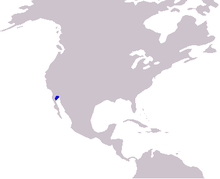Vaquita
| Vaquita | |
|---|---|
 |
|
 |
|
| Size compared to an average human | |
| Scientific classification | |
| Kingdom: | Animalia |
| Phylum: | Chordata |
| Clade: | Synapsida |
| Class: | Mammalia |
| Order: | Artiodactyla |
| Infraorder: | Cetacea |
| Family: | Phocoenidae |
| Genus: | Phocoena |
| Species: | P. sinus |
| Binomial name | |
|
Phocoena sinus Norris & McFarland, 1958 |
|
 |
|
| Vaquita range | |
The vaquita (Phocoena sinus) is a rare species of porpoise endemic to the northern part of the Gulf of California. Since the baiji (Lipotes vexillifer) is believed to have gone extinct by 2006, the vaquita has taken on the title of the most endangered cetacean in the world. It is listed as critically endangered because the estimated number of individuals dropped below 100 in 2014, putting it in imminent danger of extinction. That number was updated to approximately 60 in May 2016, leading to the conclusion that the species is headed for extinction within five years unless further conservation efforts are undertaken.
The word vaquita is Spanish for "little cow". Other names include cochito, desert porpoise, vaquita porpoise, Gulf of California harbor porpoise, Gulf of California porpoise, and gulf porpoise.
Vaquitas are the smallest and most endangered species of the cetacean order and are endemic to the northern end of the Gulf of California. The vaquita is somewhat stocky and has a classic porpoise shape. The species is distinguishable by the dark rings surrounding their eyes, patches on their lips, and a line that extends from their dorsal fins to their mouths. Their backs are a dark grey that fades to white undersides. As vaquitas mature, the shades of grey lighten. Female vaquitas tend to grow to be a bit larger than the male. Females usually end up at a length of 140.6 cm (55.4 in), compared to the males at 134.9 cm (53.1 in). The lifespan, pattern of growth, seasonal reproduction, and testes size of the vaquita are all similar to that of the harbour porpoise. The flippers are proportionately larger than other porpoises, and the fin is taller and more . The skull is smaller and the rostrum is shorter and broader than in other members of the genus.
Vaquitas use high-pitched sounds to communicate with one another and for echolocation to navigate through their habitats. They generally seem to feed and swim at a leisurely pace. Vaquitas avoid boats and are very evasive. They rise to breathe with a slow, forward motion and then disappear quickly. This lack of activity at the surface makes them difficult to observe. Vaquitas are usually alone unless they are accompanied by a calf, meaning they are less social than other porpoise species. They may also be more competitive during mating season. They are the only species belonging to the porpoise family that live in warm waters. Vaquitas are nonselective predators.
...
Wikipedia

